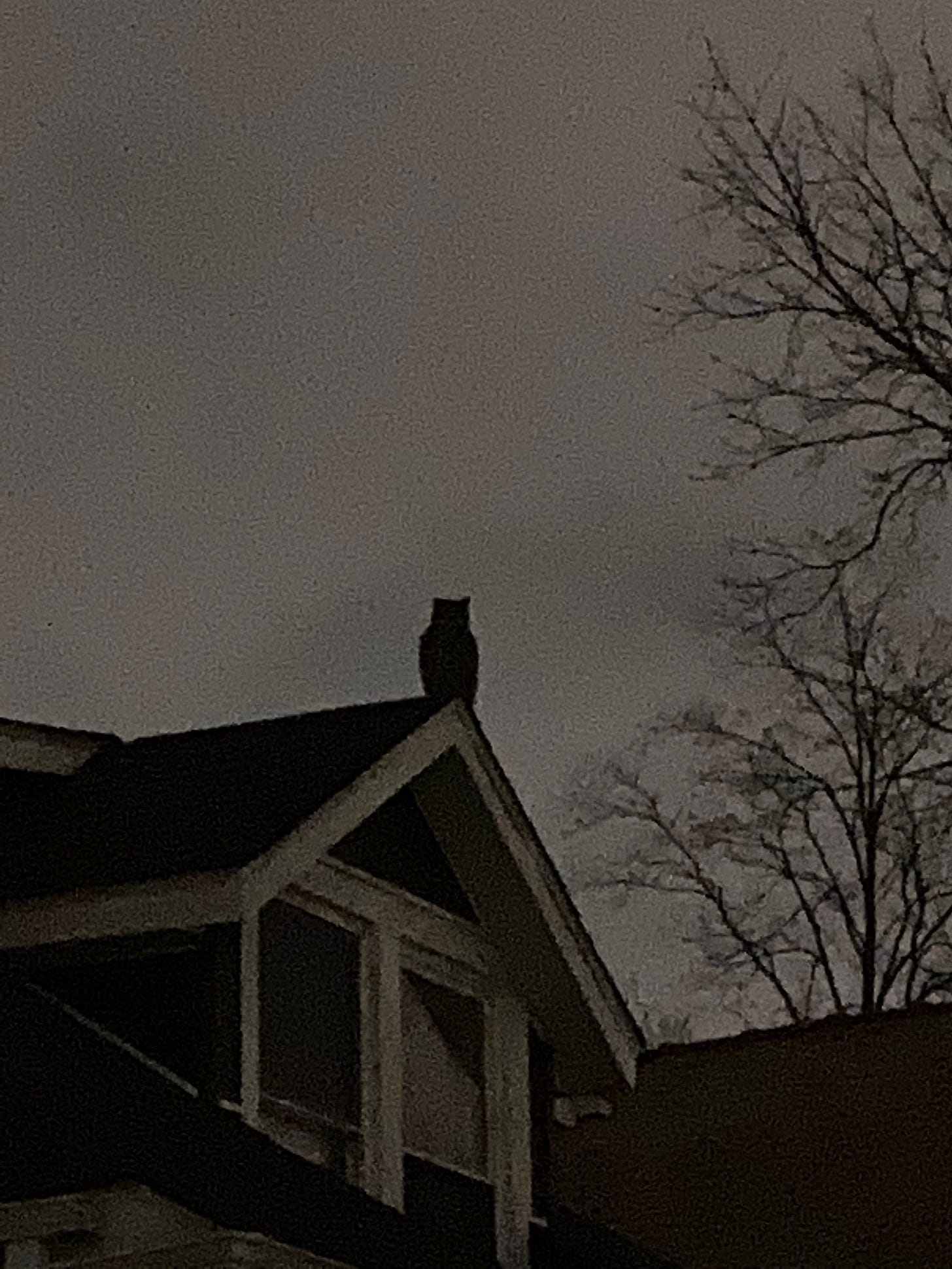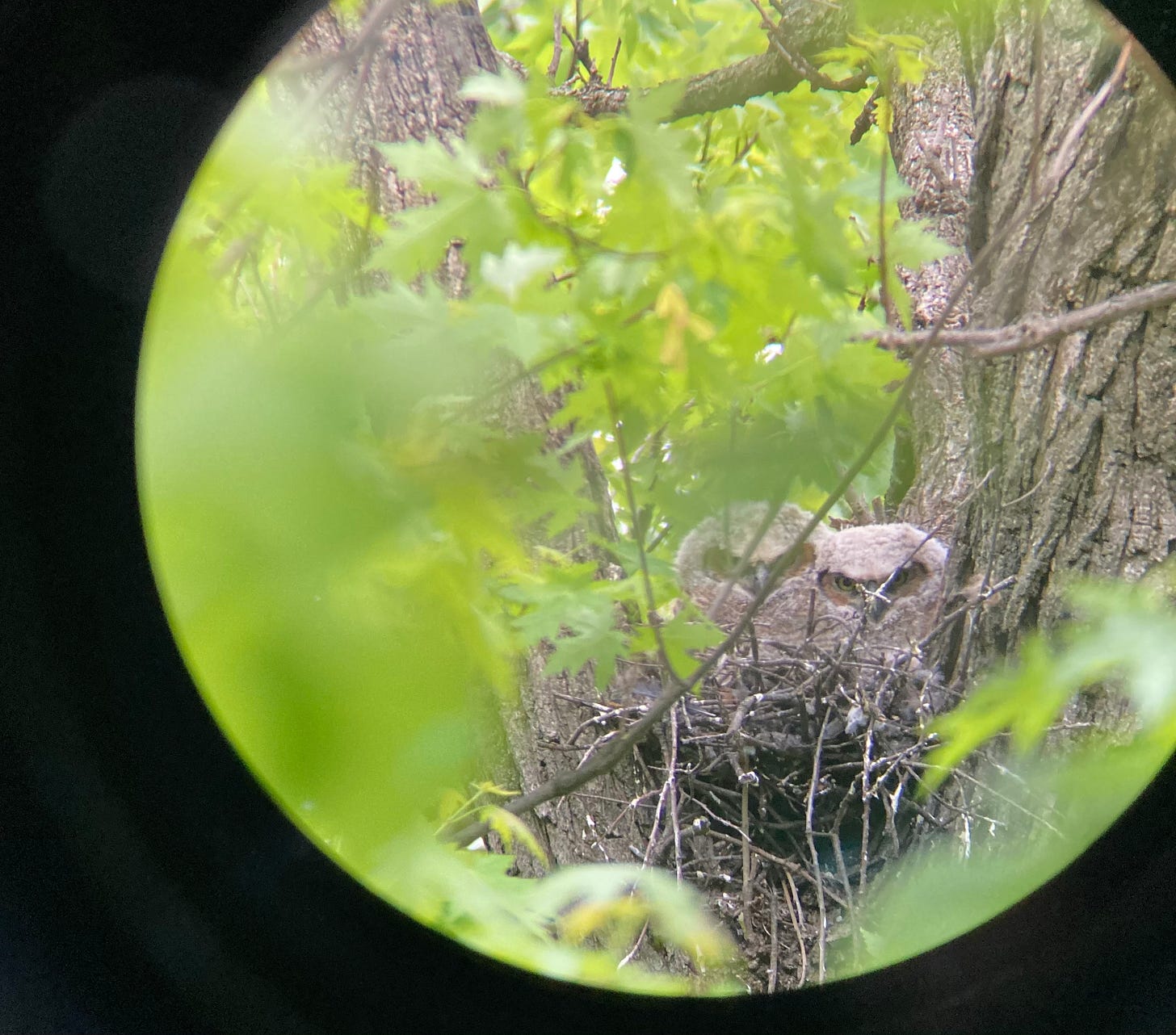Great Horned Owls become proud parents after all
A saga started on a gloomy November night on the Northwest Side of Chicago
This story starts on Thanksgiving night six months ago. The temperature was in the low 40s and skies were mostly cloudy. I was sitting by my Solo stove outside when I saw a shadowy form glide right down the street adjacent to our backyard. I did a double take. We’d only lived in our neighborhood a short time, and the thought of owls barely crossed my mind. And It’s unusual to see an owl almost any time but even weirder to see one without hearing it first.
I walked down the street after it, and sure enough there’s a Great Horned Owl swooping into my neighbor’s front yard after a rabbit. It then lands on a house a few doors down. I stood and watched it for a while and snapped a few photos with my phone.
Soon I had a couple more encounters with the first owl and another owl, presumably its mate. One night in December, I was sitting in my living room when I heard the owls calling to each other, high up in a nearby tree. Here’s what it sounded like:
I started reading up on owls in hopes of finding these birds’ nest. After all, mid-winter is owl nesting season. There’s a great 1994 book, “How to Spot an Owl” by Clay and Patricia Sutton. It makes the case that to see owls one has to start getting into an “owl-y” state of mind. The idea is to make owls your priority when in the field and to check every snag, evergreen or woodpecker hole for signs of owls. It’s a neat approach. As I tried it out, I felt more attuned to the landscape and ended up detecting the presence of other species—birds and mammals—in the process, too.
It wasn’t until a Sunday afternoon jog that I’d hear an owl again. This time there was some low hooting coming from a wooded area nearby. I walked over to check it out and spotted a Great Horned high in an oak. I didn’t see the second one at first, but soon enough could see this was a continuation of the calling I’d heard from my couch. The second one was sitting low on an old pile of sticks, probably once belonging to a Cooper’s Hawk. It was the nest.
I made a few trips back to the nest site in late January and early February to see what was going on. I assumed incubation of eggs had started. But as the weeks wore on and a snowy February turned into March, it seemed like something was up.
After six weeks had passed, well past typical incubation, I started to give up and stopped visiting as much. One owl would sit on the nest, sometimes facing to the east and away from me. Other times facing to the west. Sometimes sleeping. Sometimes not sleeping. Not much happened at all. One day I detected the mate sitting nearby. It got a little irritated with me when I set foot in the woods, so I walked back to the nearest side street to watch from afar.
I was seeing photographs on social media of other area Great Horned Owls whose broods had hatched and whose fuzzy owlets were already venturing out of the nest. I tried not to worry about keeping up with the proverbial Joneses. Sometimes things just don’t work out, or eggs aren’t viable. Any number of factors could have been at play.
Then I decided to stop by the nest one day in late April. It had been a lackluster day of birding elsewhere. I thought I’d see what the owls were up to again. This time, there was no adult on the nest, but there were a couple of fuzzy forms, like those I saw on social media. When I put my binoculars to my eyes, I finally confirmed nidification success: there were two owlets on the nest, several weeks behind schedule but just big enough to peek out.
That was about three weeks ago. The owlets were quickly getting bigger and spent their days sitting in the nest with an adult nearby. The woods had leafed out, making it much more challenging to get a look at the nest. But they’d be up there and peer right back at me when I looked through binoculars or a scope.
This week they started getting bolder and ventured out on some branches. This is at least 40 feet above the ground so it’s a perilous journey. But with already adult-sized talons, though, they’ll be fine.
They’re getting less fluffy now, and their adult feathers are starting to come in. I suspect my visit last night will be one of the last before they take off into the foliage for good.
A Birds and Bourbon chat with This Week in Birding
I shared with paid subscribers last Friday the uncanny experience I had with Prothonotary Warblers in Central Illinois. I traveled to Springfield for my second Moderna shot and met up with Jarod Hitchings at a nearby natural area to learn about the nesting boxes he’s installing for Prothonotaries. I left without seeing one, only to encounter one very unexpectedly a few hours later. Monday’s newsletter will feature a lengthier piece about these “swamp candles” as well as a little video I made.
On Thursday, May 27, I’ll be sipping bourbon and talking swamp candles with Jarod from 5-5:45 p.m. We’ll learn about his efforts to make and hang 273 nesting boxes for these golden birds of Illinois bottomlands. Register for this casual This Week in Birding conversation on Zoom below.
Remembering Darrell Shambaugh
Area birders are mourning the unexpected loss of Darrell Shambaugh of Somonauk. Darrell organized the Spring Bird Count for many years in DeKalb County. Darrell was an outstanding birder and generous with his knowledge of birds in the DeKalb area. He will be missed.
The goal with this newsletter is to raise awareness of birds and educate the public about bird conservation. This Week in Birding relies on the generosity of paid subscribers to keep this project going and provide weekly posts on Mondays and occasional Friday posts, too. By becoming a paid subscriber ($7/month or $70/year), you never miss a post in your inbox and you join a community where making films like “Monty and Rose” is possible. I try to make as many posts as possible free and accessible, but it does take resources to create original birding content.
Thank you in advance for your support, and feel free to forward this piece to a friend!









So happy to hear about these proud owl parents. Riveting article, so glad to hear they are thriving.